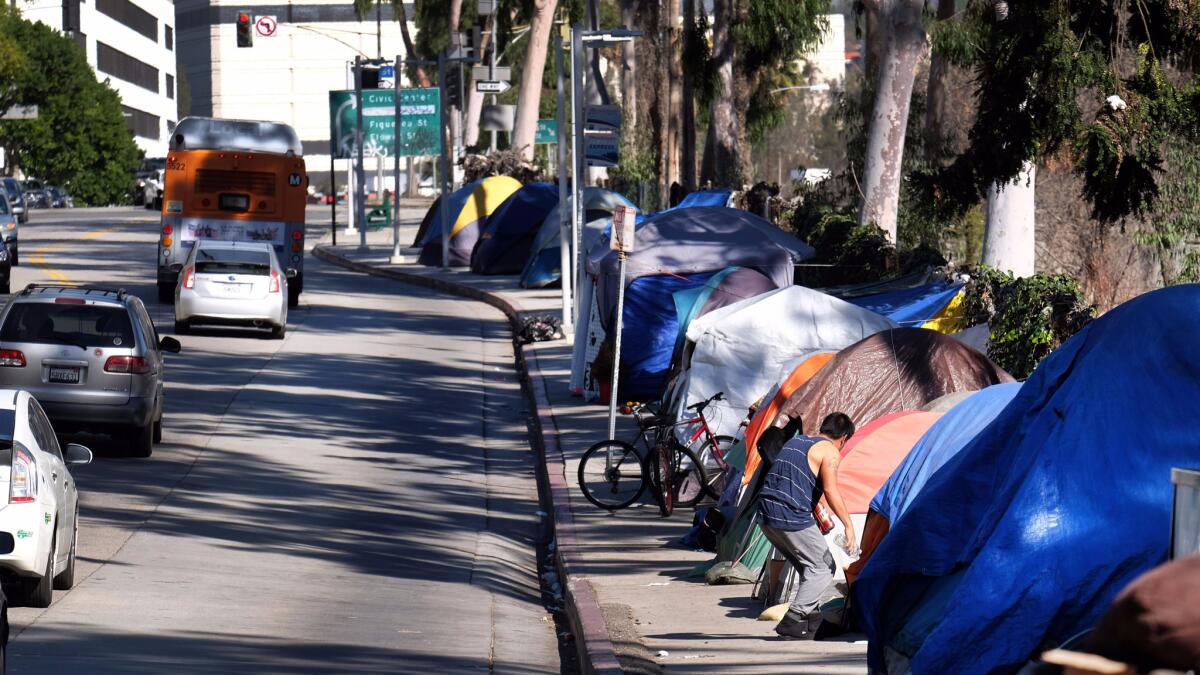Op-Ed: L.A.’s homeless can vote, but can they get to the polls to support a vital bond measure in November?

- Share via
Los Angeles will vote on a $1.2 billion bond to fund housing and other facilities to alleviate homelessness in November. It will need approval by two-thirds of city voters to pass.
No one has more riding on the outcome than the more than 28,000 people here who sleep in tents, parks and emergency shelters every night — in other words, those least likely to cast a ballot.
Being un-housed does not disqualify anyone from voting in Los Angeles or anywhere else. It took decades of advocacy by the National Coalition for the Homeless, as well as court cases striking down traditional dwelling requirements for voter eligibility, but the right to vote is protected for everyone. In the absence of an actual home, voters can designate a shelter, street corner or even a freeway underpass as their current residence. California election law requires a valid mailing address for voter registration, but that can be a shelter or social service agency, post office box, or anywhere else that the voter can retrieve mail.
Accurate statistics do not exist for homeless voter registration rates, but we know that participation tends to decline with income levels. In 2012, for instance, 80% of Americans with incomes above $150,000 voted; of those who earned less than $10,000, only 47% did.
People experiencing homelessness also are far less likely to manage the rigmarole required to, say, update their voter registration and find their way to a new polling station. After all — they’ve had a change of address, or perhaps many.
No one slides gently into planned homelessness. Rather, people end up on the streets after a traumatic eviction or after fleeing home because of domestic violence. They are trying to hold onto their jobs, their families and sometimes even their own sanity. For the swelling number of young people on the streets who are newly eligible to vote, mastering the electoral process ranks understandably lower than finding their next meal or their next “couch surfing” spot.
We cannot solve homelessness without local investment in local solutions. Right now, Los Angeles simply does not have enough beds — let alone apartments or supportive housing units — to bring these tens of thousands of people inside. The city’s unsheltered homeless population surged 21% over the past year, and without this bond to pay for housing that number will rise further. Los Angeles and other cities have waited patiently for Washington to come up with money to help, but federal homeless assistance grants have increased only 6% in inflation-adjusted dollars over the last 30 years, even as the situation on our streets continues to deteriorate.
Local political pressure to resolve this crisis is the primary reason the City Council agreed to place the homelessness bond on the November ballot. Angelenos are alarmed by the growing presence of encampments and the transformation of public spaces into horrible scenes of destitution. Two polls earlier this year indicated city voters’ support for a homeless bond at 74% and 88%, respectively.
An alliance of 57 affordable housing organizations and homeless service providers is gearing up a voter registration drive for their clients between now and the Oct. 24 deadline. Those of us who serve this population are committed to making the voices of the homeless heard. Even with these efforts, however, we know voter turnout will be low for people experiencing homelessness. Imagine how difficult voting is in their circumstances.
It will be up to the rest of us to help bolster their voice.
Jerry Jones is policy director of Inner City Law Center in skid row and has led national voter registration drives as the former director of Project Vote and the Community Voting Project.
Follow the Opinion section on Twitter @latimesopinion and Facebook
A cure for the common opinion
Get thought-provoking perspectives with our weekly newsletter.
You may occasionally receive promotional content from the Los Angeles Times.



